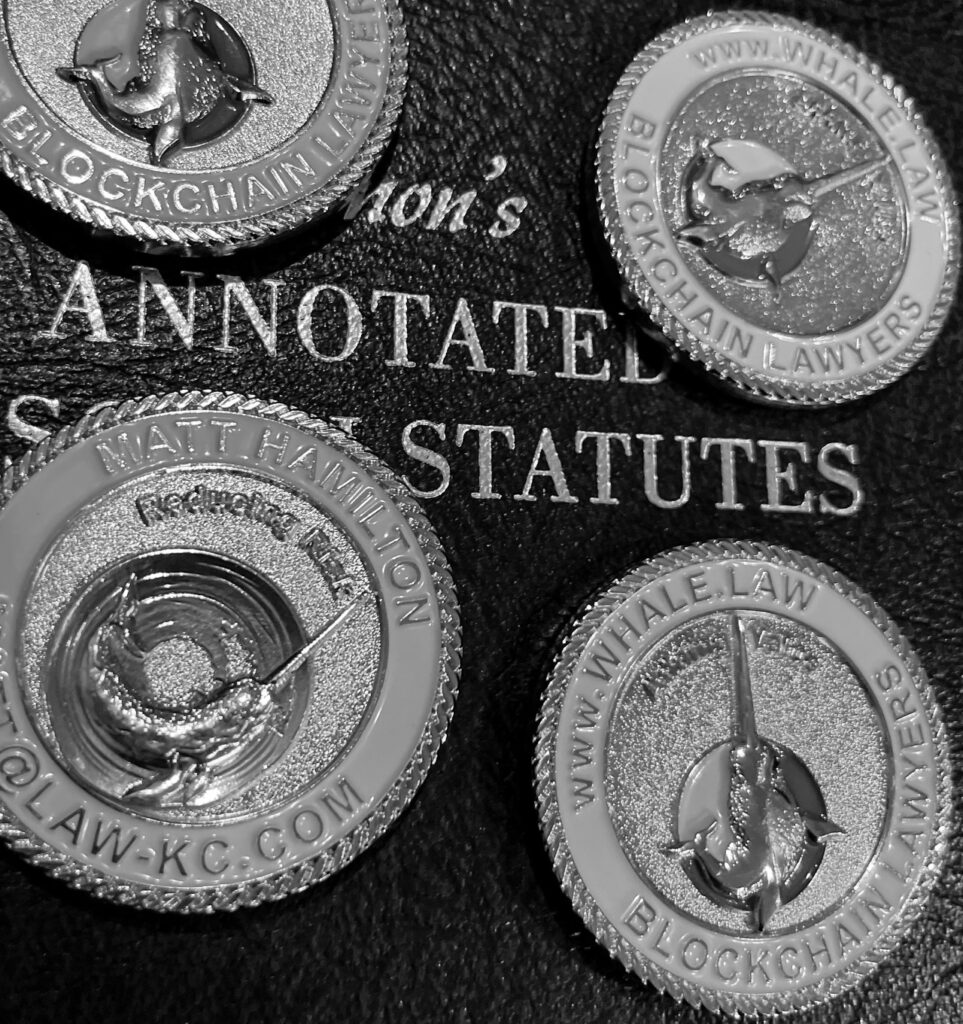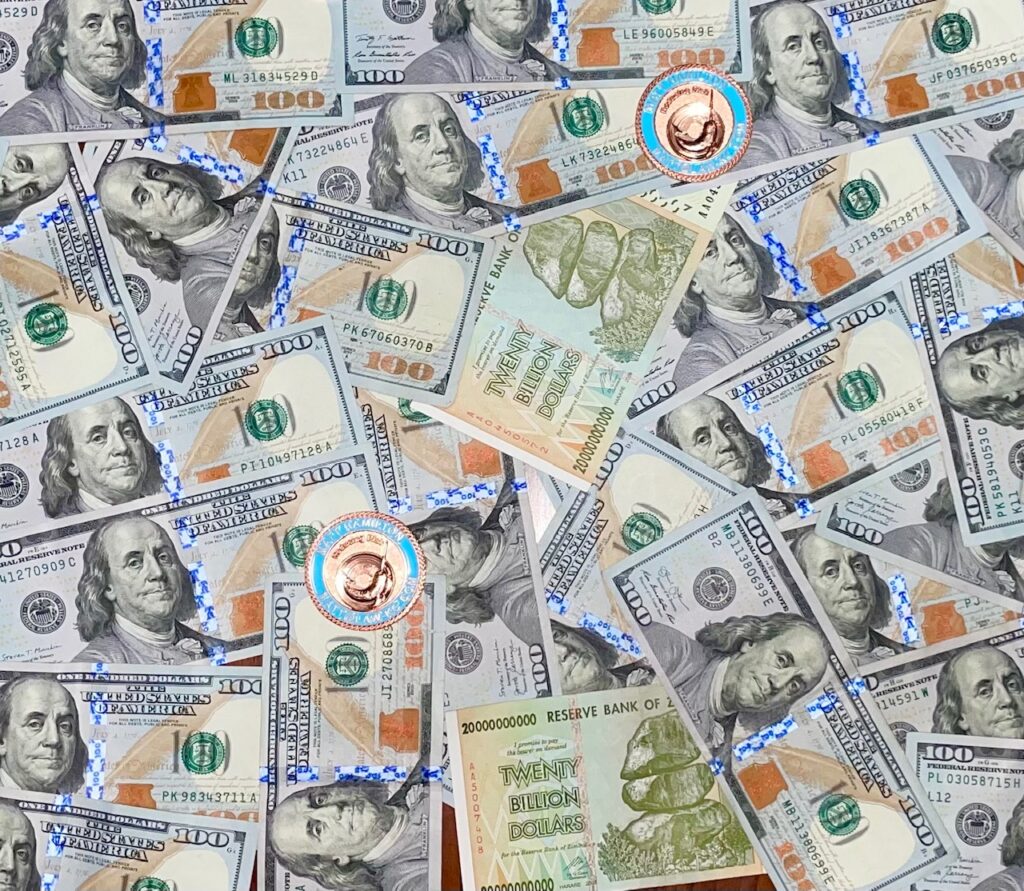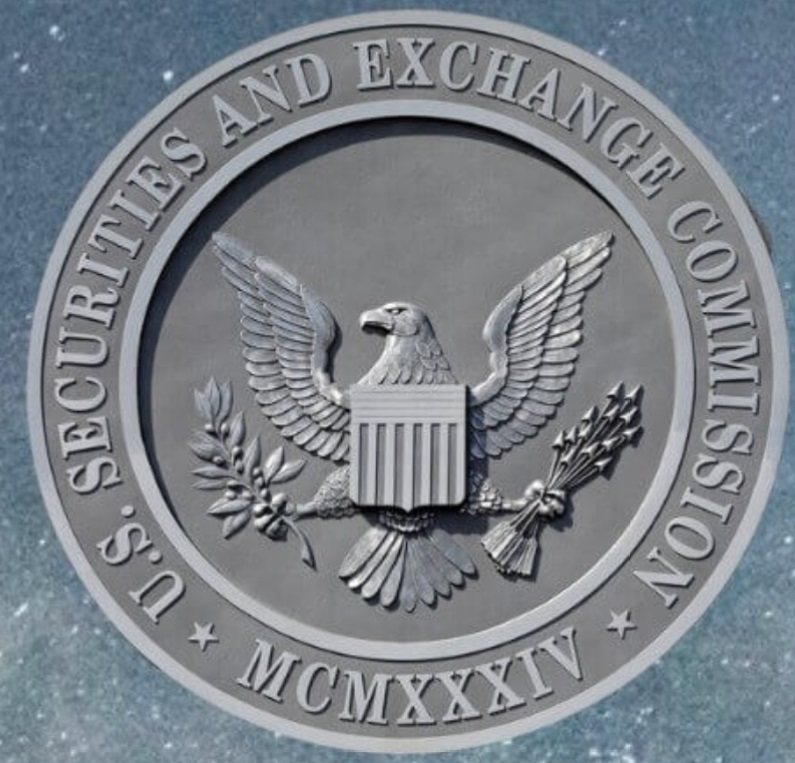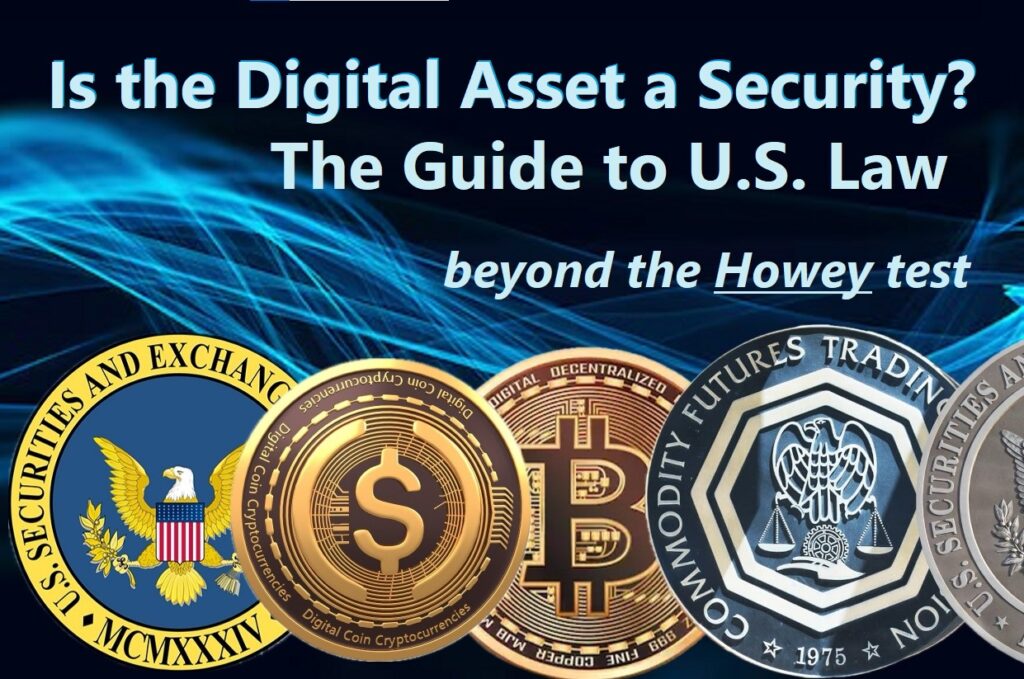Are you interested to learn whether a particular digital asset or cryptocurrency is a “security” mandating registration under United States law? Much is made of the Howey test and its four seemingly simple elements. Do not fall prey to confirmation bias, client demands, or the lure of a simple, quick answer. Those relying on a simplified version of the Howey test do so at their peril.
This article details:
1. The “Howey” test is merely the 13th out of 25 categories of securities. A digital asset that does not pass the Howey test may yet be a security.
2. The Howey test should not be thought of as having four elements, but more accurately sets out four categories of considerations in a detailed, real-world-functional analysis.
3. This article sets out the detailed test for whether a crypto asset is a security and the factors to consider.
United States Securities Statutes:
Many laws relate to the registration of securities. These include:
- The Uniform Partnership Act of 1914, adopted state by state,
- The Securities Act of 1933, also known as the “truth in securities” law, found at 15 U.S.C. §77a, et seq.,
- The Securities Act of 1934, found at 15 U.S.C. §78a, et seq.,
- The Securities Exchange Act of 1934, also known as the “exchange act,” found at 15 U.S.C. §78m,
- The Trust Indenture Act of 1939, found at 15 U.S.C. §77aaa-77bbbb, et seq.,
- The Investment Company Act of 1940, found at 15 U.S.C. §80-1, et seq.,
- The Investment Advisers Act of 1940, found at 15 U.S.C. §80b-1-21, et seq.,
- The Uniform Partnership Act of 1997, adopted state by state, excepting Louisiana,
- The Sarbanes-Oxley Act of 2002, known as Public Law Number 107-204 (2002),
- Dodd-Frank Wall Street Reform and Consumer Protection Actof 2010, known as Public Law Number 111-203, 124 Stat. 1376, and
- The JumpStart Our Business StartUps Act of 2012, also known as the “JOBS” act, Public Law Number 112-106, 126 Stat. 306.

Every state and territory has also enacted “Blue Sky” laws relating to the definition and registration of securities.
Federal securities registration centers on two regulators: the Securities and Exchange Commission (SEC) and the Commodity Futures Trading Commission (CFTC). Their Rules, Regulations, and Opinion Letters are important to a securities analysis.
25 Securities Categories
The Securities’ Act of 1933, codified as 15 U.S.C. §77b, is the foundational authority of what is a “security.” The Act sets out twenty-five categories of securities. A security is any:
- 1. Note,
- 2. Stock,
- 3. Treasury stock,
- 4. Security future,
- 5. Security-based swap,
- 6. Bond,
- 7. Debenture,
- 8. Evidence of indebtedness,
- 9. Certificate of interest or participation in any profit-sharing agreement,
- 10. Collateral-trust certificate,
- 11. Preorganization certificate or subscription,
- 12. Transferable share,
- 13. Investment contract,
- 14. Voting-trust certificate,
- 15. Certificate of deposit,
- 16. Fractional undivided interest in oil, gas, or other mineral rights,
- 17. Put,
- 18. Call,
- 19. Straddle,
- 20. Option,
- 21. Privilege on any security,
- 22. Group or index of securities (including any interest therein or based on the value thereof),
- 23. Any foreign currency put, call, straddle, option, or privilege entered into on a national securities exchange,
- 24. Any interest or instrument commonly known as a “security”, or
- 25. Any certificate of interest or participation in, temporary or interim certificate for, receipt for, guarantee of, or warrant or right to subscribe to or purchase, any of the foregoing.

Within each category, what is or is not a security is “a flexible rather than a static principal.” S.E.C. v. W.J. Howey Co., 328 U.S. 293, 299 (1946). Let us address each category, in turn.
- 1. A “note” is a security
A note is a debt security obligating repayment of a loan, at a predetermined interest rate, within a defined time frame. Notes are similar to bonds but typically have an earlier maturity date than other debt securities, such as bonds.
- 2. A “stock” is a security
Stock is the fractional ownership of a public corporation, which may include the right to vote for company directors or to receive a small slice of the profits.
- 3. “Treasury stock” is a security
Treasury stock is outstanding stock that has been repurchased and is held by the issuing company. Treasury stock is a contra-equity account because it reduces total shareholders’ equity on a company’s balance sheet.
- 4. A “security future” is a security
A security future is a contract of sale for future delivery of a single security or of a narrow-based security index, including any interest therein or based on the value thereof, except an exempted security under section 3(a)(12) of the Securities Exchange Act of 1934 (15 U.S.C. 78c(a)(12)).
- 5. A “security-based swap” is a security
A security-based swap (SBS) is a contract, agreement, or transaction that references a security or loan.
- 6. A “bond” is a security
A bond is a fixed-income instrument and investment product where individuals lend money to a government or company at a certain interest rate for an amount of time. The entity repays individuals with interest in addition to the original face value of the bond.
- 7. A “debenture” is a security
A debenture is a type of long-term business debt not secured by collateral.
- 8. “Evidence of indebtedness” is a security
Evidence of indebtedness is a promise to pay back borrowed money with interest. It is collateral given or pledged to guarantee the fulfillment of an obligation.
- 9. A “certificate of indebtedness/participation” is a security
A certificate of participation (COP) represents a percentage interest in the right to receive lease payments. Investors receive a certificate that entitles them to a share of the revenue generated from the lease.
- 10. A “collateral-trust certificate” is a security
A collateral trust bond, also known as collateral trust certificate, or collateral trust note is a bond secured by one or more financial assets. It is deposited and held by a trustee for the holders of the bond.
- 11(a). A “preorganization certificate” is a security
A pledge by an investor to buy a security from a company that is not yet formed is a preorganization certificate. Companies use preorganization certificates to secure capital before they are officially formed.
- 11(b). A “preorganization subscription” is a security
A preorganization subscription is an offer or sale that is not binding. Subscribers cannot pay until these securities are legally sold.
- 12. A “transferable share” is a security
A Transferable Share is a financial instrument that can be readily exchanged between two parties, or can be exchanged for a cash settlement. A transferable share may be a share in a corporation, a partnership, or another type of entity. A transferable share may be a securitized debt, like a bond or depository receipt.
- 13. An investment contract” is a security
An investment contract is a legal agreement between two parties where one party invests money in a business with the expectation of a financial return. The investment contract is the category of security that created the famed “Howey” test, cited as Securities and Exchange Commission v. W.J. Howey Co., 328 U.S. 293 (1946). More on the Howey test later in this article.
- 14. A “voting-trust certificate” is a security
A voting trust certificate is a document used to give temporary voting control over a corporation to one or several individuals. It is issued to a shareholder and represents the normal rights of any other stockholder, such as receiving quarterly dividends in exchange for their common shares.
- 15. A “certificate of deposit” is a security.
A certificate of deposit (CD) is a savings account that holds a fixed amount of money for a fixed period of time, such as six months, one year, or five years, and in exchange, the issuing bank pays interest. When the depositor cashes in or redeems the CD, the originally invested money plus any interest is received.
- 16. The “fractional undivided interest in oil, gas, or other mineral rights” is a security.
The “fractional undivided interest in oil, gas, or other mineral rights” is a situation where someone owns a portion (a fraction) of the rights to extract oil, gas, or other minerals from a piece of land. It is a partial ownership stake in the mineral rights of a property, meaning the investor is entitled to a portion of the profits generated from the extraction of oil, gas, or other minerals from that land. Examples include Royalty interest, and Working interest.
- 17. A “put option” is a security.
A put option (or “put”) is a contract giving the option buyer the right, but not the obligation, to sell—or sell short—a specified amount of an underlying security at a predetermined price within a specified time frame.
- 18. A “call option” is a security.
A call option (or “Call”) is a contract giving the owner the right, but not the obligation, to buy an underlying security at a specific price within a specified time. The specified price is called the strike price, and the specified time during which the sale can be made is its expiration (expiry) or time to maturity.
- 19. A “straddle strategy” is a security.
A straddle strategy (or “Straddle”) is a neutral options strategy that involves simultaneously buying (long position) both a put option (leg one) and a call option (leg two) for the underlying security with the same strike price and the same expiration date.
- 20. An “option” is a security.
An option is a financial instrument known as a derivative that conveys to the purchaser (the option holder) the right, but not the obligation, to buy or sell a set quantity or dollar value of a particular asset at a fixed price by a set date. Calls and Puts are examples of option contracts.
- 21. A “privilege on any security” is a security.
A Privilege of an investment security includes the conversion privilege and exchange privilege. A Conversion privilege allows investors to move their money between different portfolios within the same mutual fund family without paying additional sales charges. This can be useful for investors who want to change their investment objectives or adapt to market conditions. An Exchange privilege allows investors to move their money between different funds within the same mutual fund family. This can be useful for investors who want to rotate their investment strategy based on market conditions.
- 22. A “group or index of securities” is a security.
A “group or index of securities” refers to a collection of multiple individual securities, like stocks or bonds, that are grouped together to represent a specific market segment or asset class, often used as a benchmark to measure overall market performance, and is commonly called a “market index” or simply “index” in finance; examples include the S&P 500 or the Nasdaq Composite. The interest on a group index of securities is a security, as well.
- 23. “Foreign currency options, calls, puts, privileges, and group indexes” are securities.
A foreign currency exchange option is the right to sell money in one currency and buy money in another currency at a fixed date and rate. Strike and spot prices are aspects of foreign currency trading. The Strike price of the asset is the price at which the investor can exercise an option. The Spot price is the price of the asset at the time of the trade.
- 24. “Interest or instrument commonly known as a ‘security’” is a security.
A security “interest” is a legal right granted by a debtor to a creditor over the debtor’s property (usually referred to as the collateral) which enables the creditor to have recourse to the property if the debtor defaults in making payment or otherwise performing the secured obligations.
- 25. A “certificate of interest” is a security.
A certificate of interest is participation in a profit-sharing agreement, or in an oil, gas, or other mineral royalty or lease.

Can “Money” be a Security?
Yes. Money can be a security. “Money” can be cash, goods, or services and be considered an “investment” subject to securities laws. See Uselton v. Comm. Lovelace Motor Freight, Inc., 940 F.2d 564, 574 (10th Cir. 1991) (holding that an “’investment’ may take the form of ‘goods and services,’ or some other ‘exchange of value’”)
Economic Reality Trumps Form in Securities Analysis
Legal formalisms are inadequate for a securities analysis; rather, the economics of the transaction under investigation with an emphasis on the economic reality must be the substance of the analysis. Tcherepnin v. Knight, 389 U. S. 332, 389 U. S. 336 (1967).
In analyzing whether a cryptocurrency, digital asset, or blockchain network is an investment contract, “form should be disregarded for substance and the emphasis should be on economic reality” and the “totality of circumstances.” Tcherepnin v. Knight, 389 U.S. 332, 336 (1967); Glen-Arden Commodities, Inc. v. Constantino, 493 F.2d 1027, 1034 (2d Cir. 1974).

Are Digital Assets “Securities” under United States Law?
Digital assets are known by various names:
- Cryptocurrency
- Tokens
- Tokenized Asset
- Tokenized Real-World Asset
- Virtual currency
- Blockchain asset
- Digital holdings
- Crypto coins
- Cyber-money
- Electronic assets
- E-cash
- Bitcoin
- Gold 2.0
- Digital currency
- Peer-to-peer money
- Magic internet money


Can Cryptocurrency Used as Money be a Security?
Yes. The analysis is not the intent of the cryptocurrency’s development team or its name. A full analysis of the cryptocurrency and its practical use must be completed before it can be declared simply “money” and not a security. See SEC v. Shavers, No. 4:13-CV-416, 2014 WL 4652121, at *1 (E.D. Tex. Sept. 18, 2014) (holding that an investment of Bitcoin, a virtual currency, meets the first prong of Howey), and Balestra v. ATBCOIN LLC, F.Supp.3d 340 (S.D.N.Y. 2019)(finding digital tokens to be securities when the Howey elements are met).
The Family Resemblance Test – What if the crypto digital asset “kind of” or “sort of” looks like something that is not a Security?
The United States Supreme Court created a “family resemblance” test as a means for a business to persuade the government that its offering is not a security. Reves v. Ernst & Young, 494 U.S. 56 (1990). “The ‘family resemblance’ test permits an issuer to rebut the presumption that an asset is a security if it can show that the asset in question ‘bear[s] a strong family resemblance’ to an asset on the judicially crafted list of exceptions, or convinces the court to add a new instrument to the list.” Reves, at 494; Chemical Bank v. Arthur Andersen & Co., 726 F.2d 930, 939 (CA2 1984). For example, an offering of tokenized real estate as a real world asset as resembling ordinary real estate and not a digital asset security.
Many Types of Assets have been considered Securities
An interesting list of obscure assets have already been held to be investment contract securities. Howey and its progenitors held that investment contracts include:
- Oil barrels – SEC v. Crude Oil Corp., 93 F.2d 844, 848 (7th Cir. 1937)
- Silver foxes – SEC v. Payne, 35 F. Supp. 873, 877 (S.D.N.Y. 1940)
- Fishing boats – SEC v. Pyne, 33 F. Supp. 988, 989 (D. Mass. 1940)
- Orange Groves – SEC v. T.J. Howey Co., 328 U.S. 293 (1946)
- Whiskey casks – Glen-Arden Commodities v. Costantino, 493 F.2d 1027
- Payphones – SEC v. Edwards, 540 U.S. 389 (2004)
- Condominiums – Hocking v. Dubois, 885 F.2d 1449 (9th Cir. 1989), cert. denied, 494 U.S. 1078 (1990)
- Beavers – Cont’l Mktg. Corp. v. SEC, 387 F.2d 466 (10th Cir. 1967)
- Digital tokens – SEC v. Telegram Grp. Inc., 448 F. Supp. 3d 352 (S.D.N.Y. 2020)
In each of these cases, the subject was a standalone asset, which was not itself inherently an investment contract.
Are Digital Assets Investment Contracts?
There is a great debate whether these electronic stores of value qualify under one of the twenty-five categories of “Securities” under United States law. The most frequently cited category has been #13, the “investment contract.”
What is an Investment Contract?
Under the Securities Act, an investment contract is “a contract, transaction, or scheme” whereby a person
(1) invests his money
(2) in a common enterprise and
(3) is led to expect profits solely from the efforts of the promoter or a third party.
SEC v. W.J. Howey Co., 328 U.S. at 298–99 (1946); SEC v. Edwards, 540 U.S. 389, 393 (2004).

Essential Ingredients are Not An Added Element to the Howey Investment Contract Test
Some cryptocurrency advocates have attempted to add “essential ingredients” elements to the Howey investment contract test. Proponents argue for three “essential ingredients” to be added. These are:
(1) a contract between a promoter and an investor that establishes the investor’s rights as to an investment,” which contract,
(2) imposes post-sale obligations on the promoter to take specific actions for the investor’s benefit, and
(3) grants the investor a right to share in profits from the promoter’s efforts to generate a return on the use of investor funds.
A large body of case law declines to add the “essential ingredients” elements. E.g. SEC v. Kik Interactive Inc., 492 F. Supp. 3d 169, 175–80 (S.D.N.Y. 2020); Balestra v. ATBCOIN LLC, 380 F. Supp. 3d 340, 354 (S.D.N.Y. 2019). No court has adopted “essential ingredients” elements to the Howey test. SEC v. Ripple, 1:20-cv-10832-AT-SN (S.D.N.Y. 7-13-23).
Investment Contract – Howey Prong One – The Investment of Money
The first prong of Howey examines whether an “investment of money” was part of the relevant transaction. The proper inquiry is whether capital was provided, Howey, 328 U.S. at 300, whether money was “put up,” Glen-Arden, 493 F.2d at 1034, or cash was “provided.” Telegram, 448 F. Supp. 3d at 368–69. An “investment” is the commitment of the thing of value (the “money”). Long understood to be defined as “to lay it out, so that it may produce a revenue or income.” BLACK’S LAW DICTIONARY 960 (4th ed. 1951).
When is it deemed to be money? It is “money,” in essence, if it has value. The “money” need not be what the public traditionally considers as “money,” like paper fiat currency. SEC v. Rubera, 350 F.3d 1084, 1089 (9th Cir. 2003).

Investment Contract – Howey Prong Two – The Common Enterprise
The second prong of Howey, the existence of a “common enterprise” may be demonstrated through a showing of “horizontal commonality,” Revak v. SEC Realty Corp., 18 F.3d 81, 87 (2d Cir. 1994). Horizontal commonality exists where the investors’ assets are pooled and the fortunes of each investor are tied to the fortunes of other investors, as well as to the success of the overall enterprise. SEC v. SG Ltd., 265 F.3d 42, 49 (1st Cir. 2001). Horizontal commonality involves the pooling of assets from multiple investors so that all share in the profits and risks of the enterprise. ATBCOIN LLC, 380 F. Supp. 3d at 353.
Telegram Group, Inc and TON Issuer Inc., 1:19-CV-09439-PKC (S.D.N.Y. 2020) shows the applicability of a blockchain technology offering being defined a security through a horizontal common enterprise. The essence of “Horizontal Common Enterprise” is that investors are tied together in their benefits (profits) and risks (losses).
Strict vertical commonality should also be considered in determining whether a crypto digital asset is a security. In strict vertical commonality, the fortunes of the investors and promoters are linked. It is not necessary that the funds of investors are pooled. Instead, U.S. courts look for a direct correlation between the profits/benefits and risks/losses of the promoters and the investors.

Investment Contract – Howey Prong Three – A Reasonable Expectation of Profits
The third prong of Howey examines whether the economic reality led investors to have “a reasonable expectation of profits derived from the entrepreneurial or managerial efforts of others.” United Hous. Found., Inc. v. Forman, 421 U.S. 837, 852 (1975). For digital assets, profit means an income or return, dividends, periodic payments, or the increased value of the cryptocurrency. Edwards, 540 U.S. 394. The reasonable expectation of profit from the need not be the sole reason a purchaser buys the digital asset. The inquiry is an objective one. It focuses on the promises and offers made to those who buy the digital asset. It is not an inquiry into the motivation of each individual participant. Warfield v. Alaniz, 569 F.3d 1015, 1021 (9th Cir. 2009).

Investment Contract – Howey Prong Four – Reliance on the Efforts of Others to Profit
The fourth prong of the Howey test relating to the presence or absence of a security is whether investment profits/benefits derive from the efforts of others. This can be another person, another group of persons, another entity, or another group of entities.
Analyzing this prong, courts consider whether the potential investors expect to receive profits from their own efforts (use of rights or services obtained from promoters) or from the efforts of others (promoters, managers). The keystone of this element is that the investor is not the person creating the benefit/profit.
The inquiry into whether an investor is relying on the efforts of others focuses on two key issues:
- Does the investor reasonably expect to rely on the efforts of another party?
- Are those efforts “undeniably significant ones, those essential managerial efforts which affect the failure or success of the enterprise,” as opposed to efforts that are more ministerial in nature?

Broad vertical commonality is a judicial concept that has been used for the second and fourth element of the Howey Test “Solely from the Managerial Efforts of Others.” It exists when investor success depends on the performance of the managers or third parties. If investors uniformly rely on a single promoter, or group of promoter’s expertise, then there is broad vertical commonality, and the common enterprise element of the Howey Test is met.
Factors Upon Which the Securities and Exchange Commission Places Focus to Determine Whether a Digital Asset is a Security.
The S.E.C. has published a series of ingredients it considers poignant when it analyzes whether to deem a digital asset a security. The more ingredients, the more likely the crypto is a “security” and needs formal registration. These are the SEC ingredients:


Howey Test Prong #3 – Reliance on the Efforts of Others
The third prong of the Howey test, Reliance on the Efforts of Others presents two issues:
- Do the purchasers of the digital asset reasonably expect to rely on the efforts of other active participants?
- Are the efforts of these other active participants “undeniably significant?” Undeniably significant means essential managerial efforts affecting the failure or success of the enterprise, as opposed to ministerial efforts.
Active Participants / The Development Team / Others Who Are Not the Purchaser
Are the people involved in the digital asset who are not the purchaser responsible for the asset’s development, improvement (or enhancement), operation, or promotion?
- Is the network or the digital asset still in development? In other words, is it not fully functional at the time of the offer or sale?
- Are they expected to further develop its functionality?
- Are essential tasks expected to be performed by those associated with the project and not unaffiliated users (like a “decentralized” network)?
- Do they decide governance issues?
- Do they control code updates?
- Do they retain access to the project’s confidential information?
- Do they participate in the validation of transactions?
- Are they involved in the deployment of funds raised from sales of the asset?
- Will they be spending funds from proceeds or operations to enhance the functionality or value of the digital asset?
- Are they responsible for asset security?
- Do they validate project transactions?
- Does the digital asset function in reality as intended?
Factors Relating to Whether Asset Profits are Tied to the Efforts of Others?
In other words, do digital asset purchasers reasonably expect other active participants to perform or oversee tasks that are necessary for the digital asset to achieve or retain its intended purpose or functionality?
- Does the digital asset presently have limited functionality?
- Does the asset or its network have built-in incentives encouraging its functional use?
- Do they control whether to compensate persons providing services relating to the asset?
- Do they control how persons providing services relating to the asset are compensated?
- Have they promised further development efforts for the asset to grow in value?
- Do they control whether the asset will trade?
- Do they control how the asset will trade?
- Do they control who will receive additional digital assets?
- Do they determine the conditions under which others will receive additional digital assets?
- Do purchasers rely upon them for liquidity?
- Do purchasers rely upon them regarding where the asset is traded?
- Do purchasers rely upon them regarding the conditions under which the asset is traded?
- Are they creating a market for the price of the digital asset?
- Are they supporting the market for the digital asset?
- Are they limiting supply of the asset?
- Are they influencing asset scarcity?
- Are they influencing asset buybacks?
- Are they influencing asset “burning?”
- Do purchasers expect those associated with the project to promote their own interests by increasing its value?
- Are asset purchaser expectations reasonable?
- Will those associated with the project profit from an increase in the asset’s value?
- Will they retain a stake in the digital asset?
- Do they distribute the digital asset as compensation to management?
- Do they tie project compensation to the digital asset’s price in the secondary market?
- Will the development team benefit from its efforts because they hold the same class of digital assets as those being distributed to the public?
- Do they own the intellectual property rights of the network or digital asset?
- Has the value of the digital asset been monetized?
Factors Considered by the SEC for Howey Test Prong #3 – Reasonable Expectation of Profits
The SEC evaluates whether purchasers of a digital asset should reasonably expect profits. Profits can be capital appreciation or participation in earnings resulting from the use of purchasers’ funds.
- Does the digital asset’s design provide for a constant or degrading value? (a reasonable purchaser would then not be expected to hold the asset as an investment)
- Transferability Restrictions: Is the transferability of the digital asset consistent with its use and not to facilitate a speculative market?
- Does the asset’s price appreciation result solely from external market forces (inflation, the economy) impacting asset supply and demand?
- Does the digital asset give each holder rights to share in the enterprise’s profits or to realize gain from its capital appreciation?
- Do profits result from the operation, promotion, improvement, or other positive developments in the network?
- Is there is a secondary trading market enabling digital asset holders to resell and realize gains?
- Does the digital asset give the holder rights to dividends or distributions?
- Is the digital asset offered broadly to potential purchasers or are offers targeted to expected users?
- With respect to cryptocurrency, can it be used to make payments in a wide variety of contexts, as a substitute for real/fiat money?
- Are the offered quantities of the digital asset indicative of investment intent or are the offered quantities indicative of expected network users? (Are offered quantities significantly greater than likely users will need, or so small to make actual use of the asset impractical)
- Barter-Price comparison: What is the correlation between the digital asset’s price and the market price of goods or services that can be acquired in exchange for the digital asset?
- Barter-Price Stability: Are there large price swings between the digital asset and the market price of goods or services that can be acquired in exchange for it?
- Profit materiality: Are any expected profits from holding the digital asset small?
- Trading Volume: Is the trading quantity of the digital asset correlated to the expected trading quantity merely for use or consumption?
- Funds Raised: Has the development team raised an amount of funds beyond what is needed to establish a functional digital asset?
Factors Considered by the SEC – How is the Digital Asset Marketed?
- Do persons associated with the asset advertise that their expertise will continue to build or grow its value?
- Is the digital asset marketed as an investment?
- Are solicited purchasers targeted as investors?
- Do marketing materials indicate that digital asset sales proceeds will develop the network or digital asset?
- Do marketing materials indicate that the future functionality of the digital asset will be delivered by persons other than the purchasers?
- Do the marketing materials promise to build a business and not deliver currently available goods or services for use?
- Do the marketing materials promote ready transferability as a key selling feature?
- Do the marketing materials emphasize the potential profitability, or the potential appreciation in the asset’s value?
- Do the marketing materials emphasize the availability of a market for the trading of the digital asset?
- Do purchasers no longer expect that the digital asset’s value will be determined by development efforts?

In Summary
These are most of the factors that determine whether a crypto asset is considered a security under United States federal securities laws. I have written a number of “token letters” setting out a legal opinion of whether a particular digital asset is a security. These token letters are more specific and contain a more thorough and persuasive analysis of the asset under focus. My point is that one should not take this article as the entire analysis one should perform to determine whether a particular digital asset is a security. This will, however, get you 85% there.

Trial lawyer Matt Hamilton graduated from the University of Missouri in 1995 with Science degrees in Logistics, Marketing, and Business Administration. Juris Doctor, 1999.
Let's talk. How can we improve your business situation?


